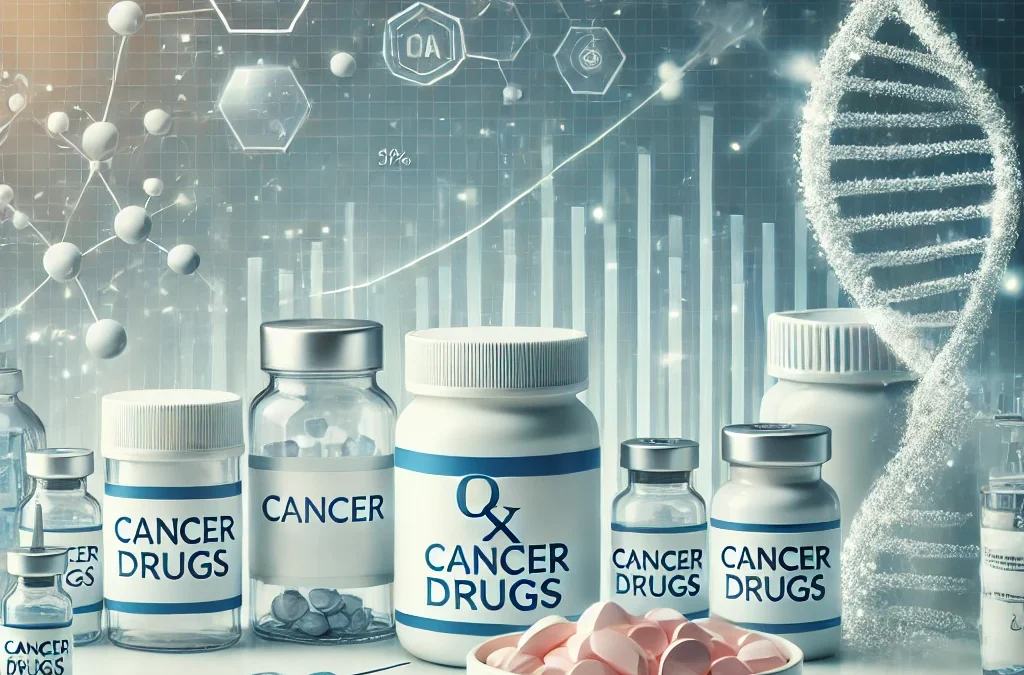Here are some of the top cancer drugs widely used in treatment, spanning chemotherapy, targeted therapy, immunotherapy, and hormone therapy:
1. Pembrolizumab (Keytruda) – Immunotherapy
- Used For: Lung cancer, melanoma, head and neck cancer, bladder cancer, Hodgkin’s lymphoma, and more.
- How It Works: A PD-1 immune checkpoint inhibitor that helps the immune system recognize and attack cancer cells.
- Common Side Effects: Fatigue, skin rash, diarrhea, and immune-related reactions (e.g., inflammation of the lungs or liver).
- Buy Pembrolizumab (Keytruda)
2. Nivolumab (Opdivo) – Immunotherapy
- Used For: Lung cancer, kidney cancer, melanoma, head and neck cancers, Hodgkin’s lymphoma.
- How It Works: Another PD-1 checkpoint inhibitor that boosts the immune system’s response against cancer cells.
- Common Side Effects: Fatigue, rash, shortness of breath, colitis, and thyroid issues.
- Buy Nivolumab (Opdivo)
3. Trastuzumab (Herceptin) – Targeted Therapy
- Used For: HER2-positive breast cancer and stomach cancer.
- How It Works: A monoclonal antibody that blocks the HER2 protein, which promotes cancer growth.
- Common Side Effects: Heart problems, fever, nausea, and flu-like symptoms.
4. Imatinib (Gleevec) – Targeted Therapy
- Used For: Chronic myeloid leukemia (CML) and gastrointestinal stromal tumors (GIST).
- How It Works: A tyrosine kinase inhibitor (TKI) that blocks the BCR-ABL fusion protein, which drives uncontrolled cell growth.
- Common Side Effects: Swelling, muscle cramps, nausea, and fatigue.
- Buy Imatinib (Gleevec)
5. Bevacizumab (Avastin) – Targeted Therapy
- Used For: Colorectal cancer, lung cancer, kidney cancer, and glioblastoma.
- How It Works: An anti-VEGF monoclonal antibody that prevents tumors from forming new blood vessels.
- Common Side Effects: High blood pressure, bleeding, blood clots, and gastrointestinal perforations.
6. Doxorubicin (Adriamycin) – Chemotherapy
- Used For: Breast cancer, bladder cancer, lymphoma, leukemia, and ovarian cancer.
- How It Works: An anthracycline chemotherapy drug that disrupts DNA replication, killing rapidly dividing cells.
- Common Side Effects: Hair loss, nausea, low blood counts, and risk of heart damage with high doses.
- Buy Doxorubicin (Adriamycin)
7. Paclitaxel (Taxol) – Chemotherapy
- Used For: Breast cancer, ovarian cancer, lung cancer, and Kaposi’s sarcoma.
- How It Works: A plant-derived chemotherapy drug that prevents cancer cells from dividing properly.
- Common Side Effects: Neuropathy, low blood counts, hair loss, and allergic reactions.
8. Cisplatin (Platinol) – Chemotherapy
- Used For: Testicular, ovarian, bladder, lung, and head and neck cancers.
- How It Works: A platinum-based chemotherapy drug that damages cancer cell DNA.
- Common Side Effects: Kidney damage, nausea, hearing loss, and neuropathy.
- Buy Cisplatin (Platinol)
9. Tamoxifen – Hormone Therapy
- Used For: Estrogen receptor-positive (ER+) breast cancer.
- How It Works: A selective estrogen receptor modulator (SERM) that blocks estrogen’s ability to fuel cancer growth.
- Common Side Effects: Hot flashes, mood changes, blood clots, and increased risk of uterine cancer.
- Buy Tamoxifen
10. Letrozole (Femara) – Hormone Therapy
- Used For: Postmenopausal hormone receptor-positive breast cancer.
- How It Works: An aromatase inhibitor that lowers estrogen levels.
- Common Side Effects: Hot flashes, joint pain, osteoporosis, and fatigue.
- Buy Letrozole (Femara)
Honorable Mentions
- Rituximab (Rituxan) – Used for non-Hodgkin’s lymphoma and chronic lymphocytic leukemia.
- Lenalidomide (Revlimid) – Used for multiple myeloma.
- Enzalutamide (Xtandi) – Used for prostate cancer. Buy Enzalufamide (Xtandi)
- Capecitabine (Xeloda) – An oral chemotherapy drug for breast and colorectal cancer. Buy Capecitabine (Xeloda)
Conclusion
These cancer drugs represent a mix of traditional chemotherapy, targeted therapies, immunotherapies, and hormone therapies. Each has unique mechanisms of action, and their effectiveness depends on the type and stage of cancer, genetic mutations, and patient health conditions.
With ongoing research, new and improved cancer drugs continue to emerge, offering better survival rates and fewer side effects for patients worldwide.



